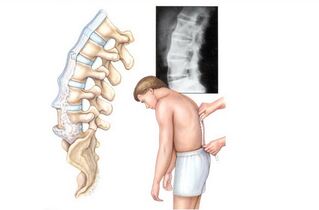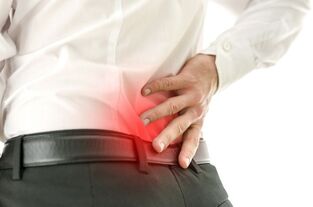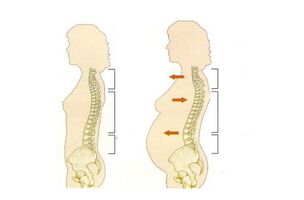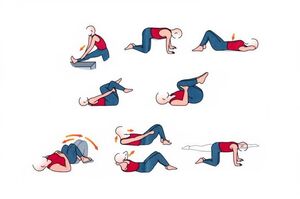Unfortunately, there is no absolutely healthy person in the world. Each of us is regularly worried about our biological state. Perhaps this is why we most often want each other to be healthy, happy, and refreshed.
Low back pain is the most common complaint. Moreover, if in childhood, we seem to only care about the elderly, then, as we grow older, the realization of wrong views will come. We do not guarantee that you will not suffer back pain by age, social status or activity type. First of all, this is due to various causes of lumbar pain and its various manifestations.
Diseases that cause low back pain
Generally, lower back pain is caused by a specific disease and is a consequence-a symptom whose nature allows a targeted diagnosis to be made, the correct diagnosis is made and the way to treat the disease is indicated. Methods and usual strategies.

Pain in the lumbar region is primary or secondary.
Primary and spinal diseases are directly related:
- Osteochondrosis or articular cartilage dystrophy disease (accounting for one-third of the total number of patient visits);
- The intervertebral disc "bulges" beyond the boundary of the spine (protrusion), the nucleus of the intervertebral disc is displaced, and the annulus fibrosus is ruptured (intervertebral hernia);
- The displacement of one or more vertebrae: forward and backward;
- Bone tissue grows along the edge of the spine in the form of spines (spondylopathies).
Secondary pain is caused by other organ diseases:
- Fractures of vertebrae caused by trauma or osteoporosis (increased bone fragility);
- A tumor appears in a part of the spinal canal (lumen);
- Muscle strain;
- Congenital spinal canal width is insufficient;
- Various curvatures and combinations of the spine, including deformities that cause the thoracic spine to appear "humped";
- Various types of arthritis/joint diseases (psoriasis, rheumatism and others); Vertebral tuberculosis and other inflammatory processes affecting the intervertebral disc;
- Kidney/urinary tract stones, pyelonephritis (kidney damage);
- Ovarian cysts, including cancer;
- Spinal pain may also be a complication of pregnancy in women.
What are the characteristics of low back pain?
Of course, it is impossible to independently diagnose the degree, degree and type of back pain. However, despite this, when the back is injured, some specific symptoms will still show us the disease.
Pain
When the lumbar spine pain is severe, the patient is likely to have osteochondrosis or sciatica. Furthermore, in the first case, it manifests itself when walking, sitting for a long time, lifting weights, and coughing or sneezing. In some cases, you may complain of back pain, which can spread to your legs.
If we are talking about radiculitis, the patient usually describes the pain as acute or dull, pain-it is unilateral and "reacts" in the thighs, calves and buttocks. It may increase with walking, coughing, and the position of the human body.
What does acute low back pain indicate?
In severe pain, you should talk about:
- Muscle stretch;
- Long-term work in an uncomfortable position on the torso;
- The back pain after sleep is due to the uncomfortable body position and staying in it for a long time; Pain during a drop, impact or sudden movement, weight lifting or weight lifting;
- Hypothermia or prolonged exposure to draught;
- There is also the possibility of low back pain (so-called low back pain), patients suffering from heavy physical labor. In this case, the lower back pain may disappear within a few days, but it may also drag and accompany a person for two or more weeks. Intervertebral disc displacement that occurs in the waist-usually related to spinal fractures, osteochondrosis, interactions with heavy objects (especially lifting heavy objects), the process of performing heavy body movements or targeted surgical interventions related to the spine.

The painful nature of pain: What is he talking about?
Pain (patients can describe it as "lower back pain" or "pull back")-often manifested by inflammation of the waist muscles.
This disease is caused by hypothermia or sudden muscle tension/tightness. In this case, the patient defines pain as pain that binds the lumbar spine, accompanied by severe pain during exercise.
Chronic persistent low back pain
If the lower back injury can even be described as chronic by the patient himself, then the most likely diagnosis will be:
- Deformable spondylosis-an increase in the amount of bone tissue in the spine caused by spine-like growth along the edges of the vertebrae (manifested as severe back pain, especially in the lumbar area, which may be combined with numbness and/or doubleLeg weakness); Vertebral joint disease-the most common is chronic systemic disease;
- A variety of tumor diseases;
- Metabolism disorder.
The pain is not fixed, it keeps moving
One of the most difficult cases of identifying a pathogenic disease is pain that occurs from time to time. At the same time, a person can be certain that his lower back will be hurt, despite the fact that the body will "deceive" him and the disease will spread to other organs.
These pains are usually caused by diseases of the pelvic organs. The inflammatory process of kidney, pancreatic disease, colon can cause lumbar pain, and inflammation may also occur due to pain changes in bone tissue and tumors of different nature.
Sometimes lower back pain is confused with shoulder blade pain. However, these are still different types of pain, and most of them are related to different diseases. So, for example, shoulder blade pain indicates gastric ulcer, myocardial infarction, intercostal neuralgia, or even a person's psychological problems.

If you find it difficult to independently identify the area where pain occurs, and it is regular or acute at the same time, you should seek medical attention immediately!
Injuries that cause lower back pain
Strangely, but usually the cause of lower back pain is an injury to the person-for example, a bruised or sprained back muscle. Seeing a doctor in time is the guarantee of correct diagnosis and treatment effect.
In advanced cases, complications are likely to occur, which does not rule out severe curvature of the spine.
Features of women's back pain
"What are the specific causes of low back pain in women? "-You ask. We will answer that there are not many of them. Generally speaking, men can thank the Creator because they have no such reasons.
The "primary" of female low back pain is:
- menstruation/menstruation;
- pregnancy;
- Orgasm.
In each case, the nature of the pain may be different. According to the direct cause, the characteristics of the female body, the degree of pressure on the lower back during pregnancy, the age of the woman, the occupation, the type of professional activity-the pain manifests itself in different ways.
Where's the man?
Unfortunately, painful lower back syndrome is common among men.
There are many reasons why he does not have a female character:
- Stretching (muscles, accompanied by severe pain);
- Spinal fractures (after a person falls, or when a person is hit in the lower back), many people suffer such injuries in car accidents; This condition usually occurs when pressure is applied to the nerve root and is diagnosed through excessive physical activity;
- The growth of cancer metastases in male genital organs is most common after the age of 50. At the same time, the pain develops with the degree of damage to the bone tissue, and the pain is so strong that it can only be relieved by taking special anesthetics, analgesics.
- Spondyloarthropathy (when one or more roots in the intervertebral canal area are damaged);
- In the case of radiating pain, it indicates the presence and development of prostate disease, liver or kidney disease.
Risk factors: What can cause low back pain?
Unfortunately, we cannot provide insurance for this disease. But we have the ability to study risk factors-the most common cause of disease onset, and take measures to eliminate these risk factors (if possible) or at least partially offset their impact on the body.
The most common obvious risk factors for lower back pain include:
- Intensive training for a lot of physical exercise (gym), especially on the spine and lumbar spine;
- Suddenly embarrassing action;
- Staying in the same location for quite a long time (for example, its activities are related to driving a car, working on a computer, or even work that is forced to stand for a long time—a consultant in a store, a pharmacist) in a pharmacy, a foreman in a factoryMachines, etc. );
- In the morning, the lower back may also be painful. This "says" that the mattress or pillow is not suitable for you, but they do not exclude the inflammatory process, so it will be reflected in the symptoms.
- Work is based on tremendous physical or psychological pressure, and pressure may also manifest as lower back pain;
- As mentioned earlier, pregnancy and childbirth also increase the possibility of low back pain.
- High body weight is also closely related to lower back pain, because the pressure on the internal organs and spine depends on the total weight.

When do you need medical care?
Just as we hate being sick, we also hate to seek help from a doctor. There are many ways to independently determine the cause of the disease and its treatment. Of course, there are reasons for this belief.
But in the case of low back pain, I still want to distinguish in a certain way: here you can lie down and receive treatment by yourself, but here-sometimes without the help of a doctor-urgent! -It's just not enough.
We can clearly say that if the pain is one-time in nature, or the cause of the pain is one of the causes of female lines, then in principle you can’t panic, but please wait, observe your body and give it a chance to rest, Don't overload.
If the pain does not disappear and there is no recurrence, then you can correctly determine the cause, and you can do it without medical intervention.
For lower back pain:
- is repeated systematically;
- Pass and continue;
- is zoomed in;
- The pain lasts for more than three days; Repeat
- in the morning;
- You were injured and related to the occurrence of waist pain;
- Immediately feel pain in the lower back and calves (feet and calf);
- Or-Lower back pain combined, buttocks and legs (thighs, calves, feet) and even the groin area become numb-this is a serious reason for urgent medical treatment!

In any of the above cases, you don’t need to guess for yourself, look for the cause of the pain, or wonder why your lower back hurts, but you should contact a medical institution immediately. Without medical assistance, the situation may deteriorate and treatment will take more time and effort.
Remember, when you can "freely" joking or expecting (for example, the deformation or displacement of the intervertebral disc has never been corrected by itself), there will be no back pain or lower back pain.
Failure to diagnose the patient’s pain and correct treatment in time may lead to serious and complex diseases, lumbar spine surgery, and even lower body paralysis and disability.

























